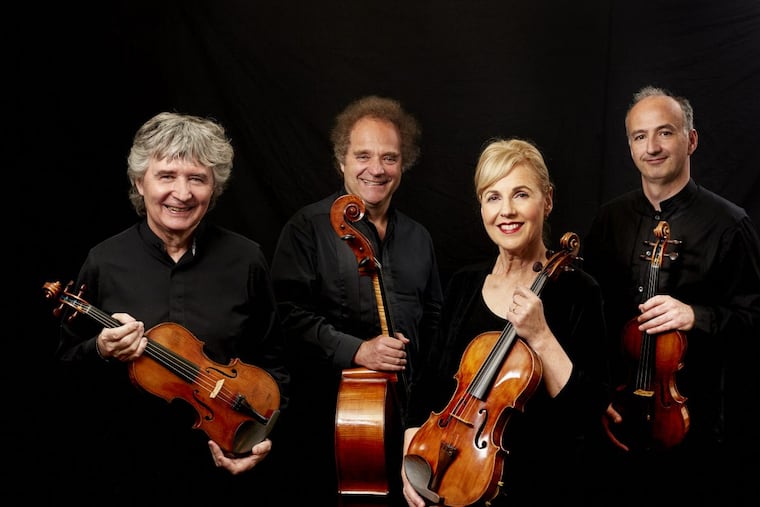Takács Quartet, in transition, is stirring at the Kimmel
The quartet revived a great piece: the Dohnányi "String Quartet in D Flat Major."

Mozart is hard. For the player, his music often leaves you exposed, with no cushy textures to lean on. And how far to go expressively?
The Takács Quartet Tuesday night reminded us how elusive Mozart's essence can be. The Takács operates at a high level, so the standard that one uses to gauge the quality of their playing is at the rarefied end of the spectrum. Still, Mozart's String Quartet in G Major, K. 387 at the Perelman Theater wasn't flush with strong ideas. It's a standard piece, and yet, opening with the work on this night, the venerable quartet was still searching for a definitive statement.
It seemed pale, especially compared to the saturated artistry in the rest of this Philadelphia Chamber Music Society concert. Their late Beethoven was wonderfully questioning and emotional. And the commitment they brought to the Dohnányi String Quartet in D Flat Major, Op. 15 (1906) showed what makes that relatively obscure work so great. If the old Curtis String Quartet recording of the piece caught the first movement as the youthful call of euphoria, the Takács made it a warm gust. They took the time to explore the movement's more soulful corners, both many and constantly in flux.
The Takács itself will soon be in flux. Károly Schranz will retire at the end of April after 43 years as founding second violinist; Harumi Rhodes will be sitting in that chair the next time they visit PCMS a year from now. Schranz didn't sound ready for retirement Tuesday night. He was refined as ever. It must be said, though, that the beloved quartet should be fine as long as they hold onto their keeper of ensemble spirit, violist Geraldine Walther.
This is a collaboration that stems, in part, from a diversity of personalities. First violinist Edward Dusinberre is prone to taking expressive chances, and cellist András Fejér offers a solid rhythmic underpinning. Part of it was the repertoire, of course, but time and time again, Walther stepped in with a melody — or even, sometimes, a single note — that would take the music in a direction more incisive, more expressively probing.
She handled her expansive solo stretches in the Dohnányi by shining a light into every note, yet connecting them in a single, longing breath. It helps that her intonation is impeccable, but it's that glowing tone that sets her apart.
Beethoven's String Quartet in C Sharp Minor, Op. 131 didn't quite work itself up into the kind of crazy state near the end that unlocks its unusual character, but elsewhere in the piece the Takács was a dream. Fleeting moments of penetrating drama multiplied. Dusinberre had some heroic statements. But again, Walther took it a dimension deeper.
It was she who added an element of yearning in the slow opening. Near the end of the Beethoven, she was the ensemble glue in moments of transition, an apt role she will no doubt be called upon to play as one-quarter of this musical family soon shifts.